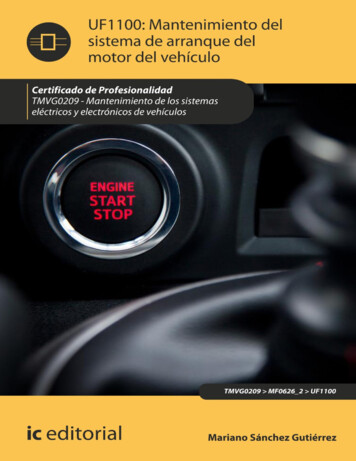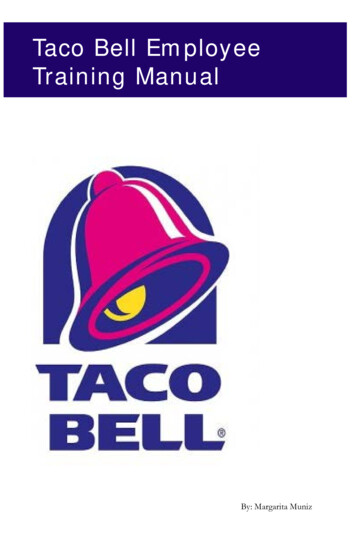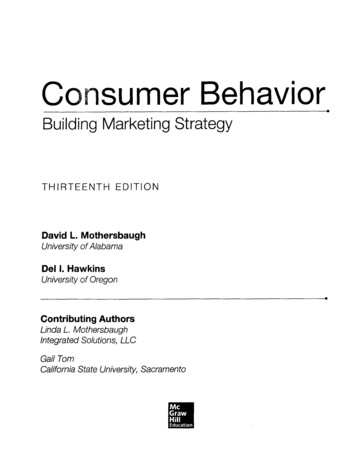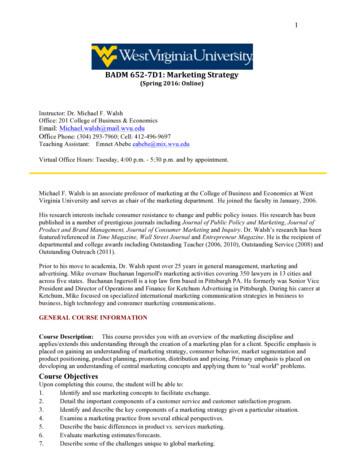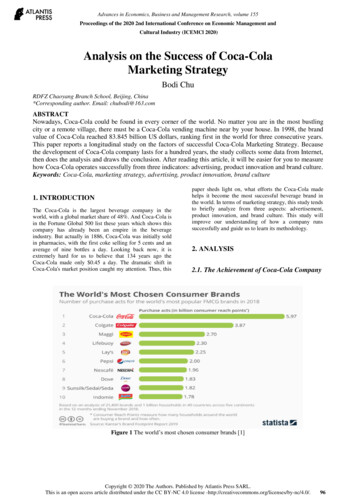
Transcription
DEL TACO MARKETING STRATEGYBRIANA CARR NICHOLE MUNROE STEPHANIE CATE JULIAN AGUILAR
2
IntroductionDel Taco is a California-based fast food outlet that has expanded its services to 500restaurants across the West Coast. With its recent expansion to the Southeast, Del Taco hasopened a franchise restaurant in Rock Hill. The goal of this marketing strategy is to create andincrease brand awareness for Del Taco in Rock Hill. In today’s highly competitive environment,it is becoming increasingly difficult to differentiate one fast food outlet from another. Afterconducting in-depth primary and secondary research through surveys and focus groups andthrough literature reviews relevant to the fast food industry, our main focus is to first establish theDel Taco brand in the community. Thereafter, our focus will shift to further increase loyalty andbrand recognition in the area so that the two primary target audiences consisting of families andyoung adult males will choose Del Taco among competing fast food restaurants.Literature Review of Secondary ResearchThe pressures of working life along with time constraints have resulted in an increasingnumber of consumers opting for fast food. One study revealed that around one-third ofconsumers felt they lacked the time to prepare healthy meals, resulting in food being consumedquickly at work or in the car. For this reason, these same people have actually replaced many oftheir meals with snacks or quick meal. Consumers have changed. The consumer's attitude aboutthe economy, their lifestyle, financial planning and shopping habits and eating behavior – it hasall changed. Why? Due to busier consumer lifestyles and dual-working families with children,emphasis is increasingly placed on quick meal solutions. In the last five years there has been arapid growth of the fast food industry in in the US.3
With such recent changes, it is important to understand the consumer in order to developsuccessful marketing strategies. This research will shed light on what it is that Del Taco can do toaccess this changing customer base. It explores consumers’ attitudes toward fast food. Morespecifically, our objectives are to identify the key attributes that influence the customerperception of fast food and to evaluate the relationship between customer loyalty and customerservices in the industry. The following discussion will address recent trends of customersregarding cost, convenience, menu and location of fast food restaurants.Influence of Food Quality on SatisfactionClark and Wood (1998) developed dimensions relevant to creating customer loyalty inrestaurant choice. Study findings suggested that food quality was the most influential predictor ofconsumer loyalty in restaurant choice. Mattila (2001) indicates that the top three reasons forcustomers to patronize target restaurants in the causal dining sector were food quality, service,and atmosphere. Specifically, food quality was the most important attribute of overall restaurantservice quality and is expected to have a positive relationship with customer satisfaction andloyalty. Thus, it can be concluded that quality of food has a positive influence on customersatisfaction.An important part of food quality is its health value. Many consumers crave healthieroptions. This has been a key change in the fast food industry. Meals normally associated with sitdown restaurants like salads and oatmeal are now offered through the drive-thru. This has led toa increase in consumers’ satisfaction with food. However, It also has created a problem formarketers. Instead of showing speed and convenience, marketers are challenged with givingconsumers the fresher, healthier products they crave.4
In Fast Feeders Serve up Fresh Buzzwords, an article by Maureen Morrison, the authorexamines how fast food restaurants are giving consumers what they are growing to expect.Morrison uses the term “fast feeders” to describe consumers who eat fast food. Premium, fresh,wholesome, natural, low-cal, and low-fat are all terms used by marketers to describe the qualityof fast food to consumers. Although such terms are highly regulated and go under examinationby government agencies, such as the Food and Drug Administration, before such claims can beadvertised, because consumers are susceptible to health gimmicks. If a food is marketed as freshor low-cal, the consumer then views that as a healthier option, and feels satisfied with their fastfood choice. Morrison states, “Today's consumers are more educated about nutrition and arelooking for ways to live healthier lifestyles as opposed to just dieting.” The new consumer seeksbalance in the drive-thru. They want the accessibility and ease but they do not want to feel guiltyabout it fast food. Morrison points out some brands like McDonalds, Arby’s, and Subway aresuccessfully marketing with these so-called buzzwords.For example, Arby’s has given consumers higher food quality through items like premiumsandwiches, and wholesome sides. Subway has used this method for a longtime with its Fresh andFit menu. McDonalds has had recent success with oatmeal. Morrison states, “Oatmeal inparticular is a fast-growing item” (18). “From 2009 to 2010, the number of oatmeal servings atfast-food restaurants jumped to 108 million from 88 million in 2007, or 23%,” He adds (24).Companies like Chick-Fil-A and Starbucks have been successful with oatmeal giving theirproducts a healthier, high-quality image. Morrison points out that “fast feeders” embrace thesefoods claiming to be healthier options. However, the core items on menus such as cheeseburgersand chicken nuggets could be put at risk of being replaced by healthier items. Another key pointMorrison adds is that the FTC (Federal Trade Commission) will not stand for deceptive5
advertisers with fast food. As long as the products are healthy, wholesome, natural, etc.consumers and marketers have open communication.Perceived Price in Relation to Satisfaction:Although quality of food is a key factor in establishing preference, another key factor,price, has been considered a significant component in explaining consumer behaviors. Perceivedprice can be described as “the customer’s judgment about a service’s average price in comparisonto its competitors”. Although many researchers have agreed that perceived price is an importantdeterminant of customers’ post-purchase behaviors, there no substantial research showing theinfluence of perceived price on consumer behaviors in the fast-food industry. Research showsthat price, convenience, and availability may increase customer satisfaction without actuallyinfluencing customer perceptions of service quality.Many researchers agree that value is highly related to price. That customers pay forquality, while the utility of a product or service is based on customer perceptions of what isreceived and what is given (money). Specifically, when customers perceive the price to bereasonable, their satisfaction with food quality will increase. So a customers’ perception ofreasonable prices in the fast-food industry may enhance the effect of quality of service oncustomer satisfaction.Customer Loyalty in Relation to Satisfaction:Research shows that the quality of food and prices are two key components in what drivesconsumers to choose what fast food restaurant to eat at. However, in order to build loyalty toyour establishment, the consumer must be satisfied in the overall experience for him or her to6
keep coming back. Therefore, improving service quality has become one of the most importantstrategies a service provider uses to differentiate itself from its competitors and thus position itselfmore effectively in the marketplace. Rust and Oliver (1994) suggested that quality is onedimension on which satisfaction is based. Their findings suggested that service quality was an“antecedent of consumer satisfaction” while consumer satisfaction was not a significant predictorof service quality. Since customer interaction has a significant impact on the customer’sperception of service quality and eventually influence a customer’s satisfaction, it should beincorporated into the management’s operational decision-making process.A recent QSR magazine survey conducted by Litchfield Research revealed that today’sconsumers do in fact have strong perceptions of a fast-food brand based on the customer servicethey receive. Nearly 45% rated the customer service at a typical fast-food restaurant assomewhat pleasant while 14% rate it as somewhat or very impolite. So a customer’s overallsatisfaction with service is based on all their encounters and experiences with the organization. Inan increasingly competitive environment, companies must be customer-oriented. It is thus notsurprising that companies spend substantial resources in measuring and managing customersatisfaction. To improve customer satisfaction and loyalty, companies must understand whatfactors influence customer satisfaction and repurchase behavior, and then try to makeimprovements in these critical areas so that they can have more satisfied and loyal customers.In the article Effects of Brand Awareness on Choice for a Common, Repeat-Purchase Product byWayne D. Hoyer and Steven P. Brown, from the Journal of Consumer Research, the authors suggestthere are multiple points to be made about consumers. An interesting part of the articledescribes how a brand and the brand identity come into play. A key part of a marketer’s job is tobuild and keep brand loyalty. In some instances a consumer is more satisfied with a brand simplybecause of frequency. The article says, “if the automatic frequency-counting mechanism counts7
substantially more instances of communications about brand A than about brand X, then aninference may be made to the effect that brand A is better known, so it must be popular andprobably better.”From the findings, it seems that people tend to believe that if a product is well knownthen they trust that the quality must be better. The experiment conducted in this study testedpeople’s preference depending on whether they knew the brands or not. It had three hypothesesthat were all proven to be true. The hypotheses are as follows: Brand Awareness serves as a dominant choice tactic among inexperiencedconsumers presented with a brand-selection task. Consumers choosing among a set of unknown brands are likely to samplemore bands across product trials than consumers who choose amount a set ofbrands that includes one well-known one. After a series of product choices, consumers choosing among a set of threetotally unknown brands are more likely to choose the high-quality brand thanare consumers who choose among a set of brands that includes one wellknown and two unknown brands, especially when the well-known brand is notthe high quality brand.The conclusion states that, “In particular, it has shown that brand awareness is aprevalent choice tactic among inexperienced consumers facing a new decision task, subjects whoare aware of one brand in a choice set tend to sample fewer brands across a series of producttrials, and subjects who are aware of one brand in a choice set tend to choose the known brandeven when it is lower in quality than other brands they have had the opportunity to sample.” In8
order to create more loyal customers they need to increase brand awareness, especially in a newarea.FOCUS GROUP ANALYSISDetails of the Focus Group SessionExplorations into secondary research pointed out the importance of quality of food, priceand the overall experience that consumers expect in order to create preference to a restaurant orbrand. With this information, it was possible to plan and execute a focus group to investigate howthose factors weighed in to this specific case, and have first-hand knowledge as what a portion ofconsumers currently think and feel about Del Taco. The focus group was conducted on February13 at 7 p.m. in the resource room of Johnson Hall, located on the Winthrop University campus.We invited approximately 17 guests by e-mail, social media, and personal requests, however onlyten of the 17 individuals showed up: Jessica, Paul, Chris, Hillary, Nicole, Chelsea, Ron, Josh,Laura, and Valentine. The demographics included four males and six females of various ethnicgroups with the average age of 22. Primarily Winthrop University students, these individuals hadall been to Del Taco no more than two times and all of them would be content with never goingback.After the greeting and introduction by Julian Aguilar, the discussion began. We tried toask open-ended questions that would allow us to understand each of their buying habits inrelation to fast food. We also inquired information on fast food preferences, decision-makingprocesses, and their overall Del Taco experience(s). Discussion started off fairly slow mainlybecause people were a little uncomfortable speaking about Del Taco in a negative light whenthey knew that we were working with them one-on-one. But after giving everyone a little9
background on focus groups and explaining how much insight it would give us if they werecompletely honest, they all opened up.During the session, we had various samples of Del Taco that Briana Carr had set up sothat the participants could taste test possible foods that they may not have tried during theirprevious visits. We tried our best to create a welcoming and relaxed atmosphere for all of theparticipants so that everybody would feel comfortable with the experience. At the end of thesession, we provided our incentives (discount coupons) in hopes to encourage them to give DelTaco another chance. All in all, we took away some great insights and I feel that the overall focusgroup was a success.Focus Group InsightThere were many common themes expressed across the focus group as well as severalitems that surprised the Core Creative team after reviewing the focus group data. These arenoted below.Common Themes: Most participants
Morrison points out some brands like McDonalds, Arby’s, and Subway are successfully marketing with these so-called buzzwords. For example, Arby’s has given consumers higher food quality through items like premium sandwiches, and wholesome sides. Subway has used this method for a longtime with its Fresh and Fit menu. McDonalds has had recent success with oatmeal. Morrison states, “Oatmeal .
